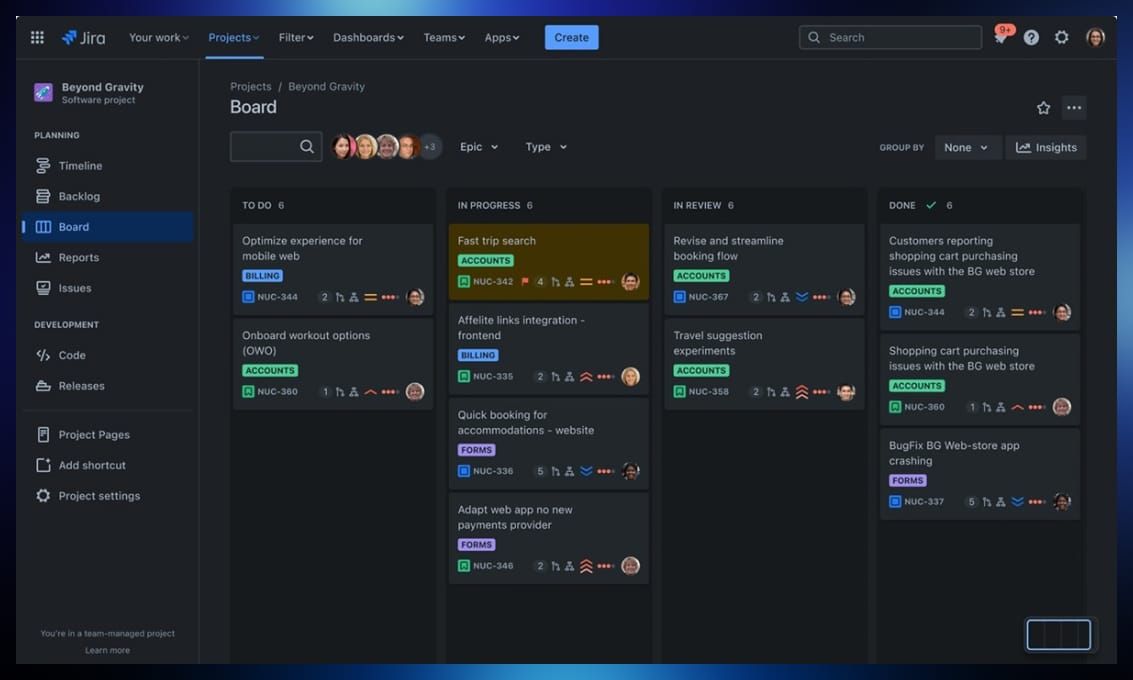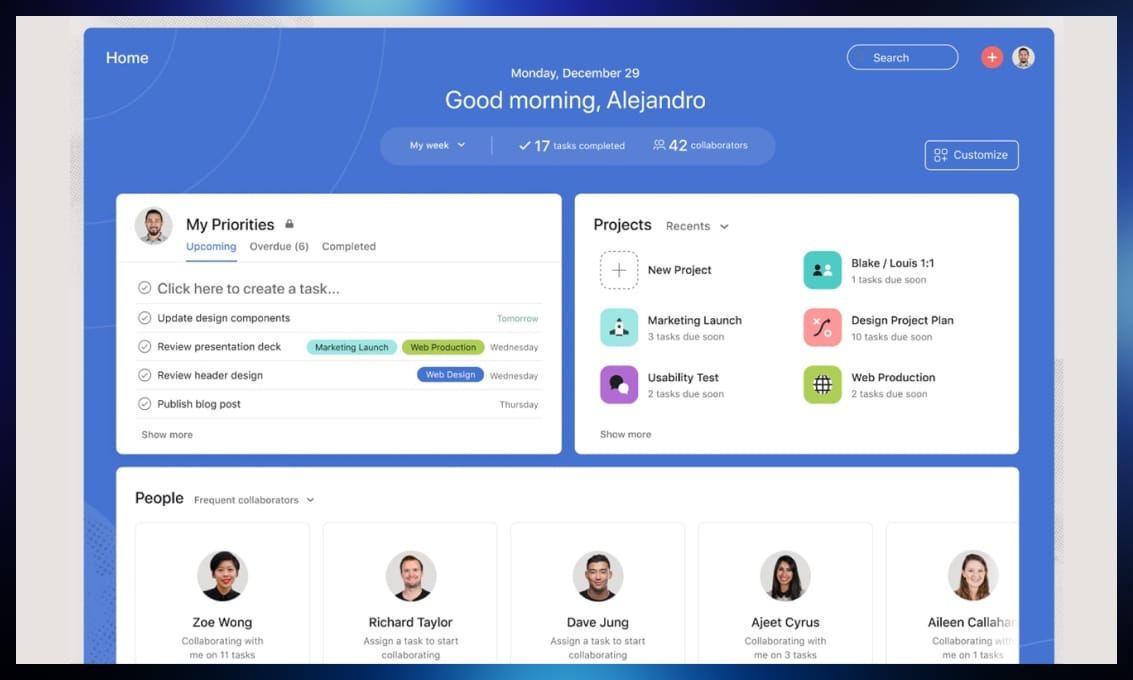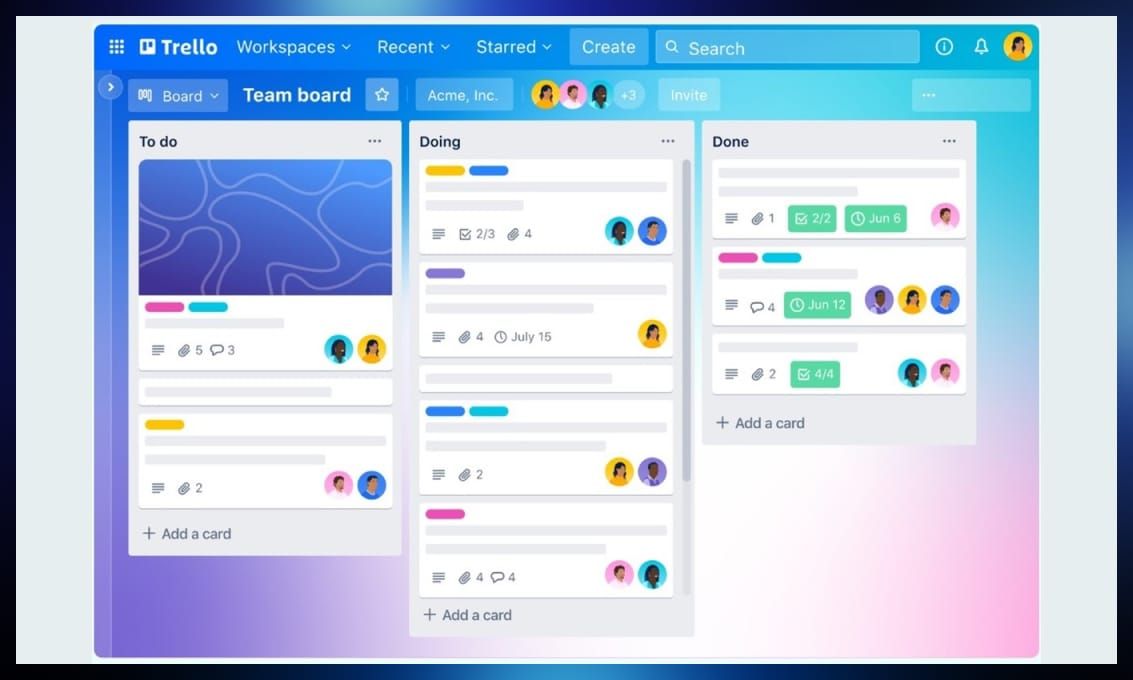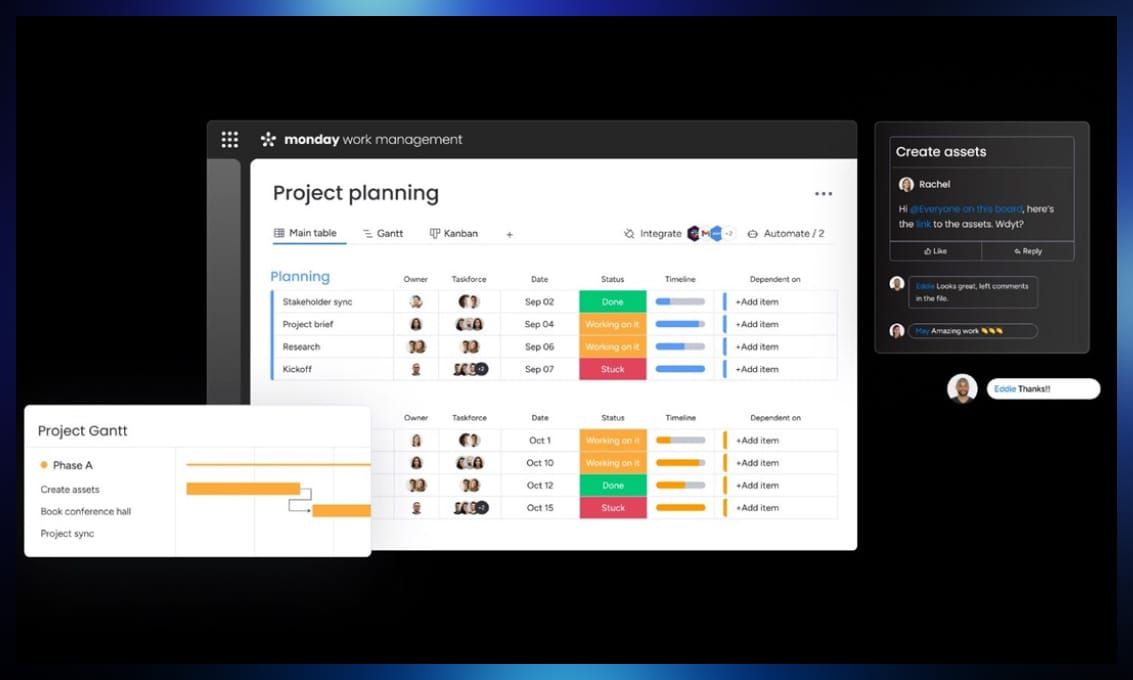No project can be a success without good management, and software projects are no different.
Stats reveal that in the IT realm, only 39% of projects are successful. 43% are challenged, and 18% are failing. This is what happens when you start a project without proper planning and management strategies in place.
Today, we are going to run you through what software development project management is, why it is so important, and what the process looks like from the inside.
Excited? Let’s get started…
What is software development project management?
Software Development Project Management (SDPM) is how we manage a software development project from start to end. It includes all the principles of project management—planning, execution, and monitoring.
SDPM provides a suitable ground for a product demand from a client to be ideated, developed, and launched as per their requirements.
A software project manager would need to organize and manage resources, people, and activities involved in completing a software project within the allocated budget, scheduled timeline, and desired quality.
This is exactly what the SDPM process is all about—successful completion of projects while fulfilling the end-user’s needs.
What are the benefits of software development project management?
Let’s have a quick look at all the benefits we get out of managing a software development project in the right way.
1. Improved organization and planning
Without a management process in place, all development projects will be like a giant puzzle to solve with missing pieces and no clues.
With SDPM in place, large, intimidating projects can become a series of achievable steps, making the path to completion clear and less overwhelming.
It will help you create a clear project roadmap and plan ensuring that nothing falls through the gap and all the necessary tasks and teams can be easily organized.
2. Effective task delegation and enhanced productivity
A project is no good without a good team that is in sync.
Project management methods and tools can help you visualize all the tasks needed to complete the project and plan in which order they should be completed.
You can then easily delegate the tasks to your team and distribute the workload evenly. Your team can also have a clear view of what is expected from them and what is on everyone’s plate.
This transparency and clarity will ultimately lead to better teamwork and productivity.
3. Remote working and better collaboration
SDPM tools make it easier to collaborate with and manage hybrid/remote teams.
This is because it equips a manager and their team with a clear picture of everything related to the project in a single space. So everybody is aligned and updated on what everybody is working on.
It offers features for team members to connect, share ideas, share updates, and documents regardless of location.
Project managers can monitor progress and identify potential issues early on, ensuring everyone is working towards the same goal.
4. Simplified project reporting and progress tracking
Reporting and progress tracking is very important to understand what is working and what is not working for a project. It is also important to keep clients updated on how things are turning out.
With SDPM methods and tools, the entire tracking and reporting process becomes very easy. You can easily track progress against set milestones, and monitor timelines, budgets, etc to ensure the project is going as expected.
Tools also come with various automated reporting features that make creating and sharing reports effortless.
Imagine all of this without SDPM, looks hard and time-consuming, right?
That’s why we need SDPM. Now, let’s take a look at 6 phases of SDPM.
Phases of software development project management
Now, moving forward to what actually happens in the entire SDPM process. There are a total of 6 phases involved.
1. Initiation phase
The initiation phase is the first phase of every project’s lifecycle. It’s all about defining the project’s purpose, scope, and feasibility.
- What problem are you trying to solve with this software?
- Who will be your target audience?
- What exactly would it offer?
- Who will be affected by your project (stakeholder)?
You must have a clear answer to all such questions.
Put your 100% into the market research and gather stakeholder input to ensure the project addresses a genuine need.
Prepare your project scope with clear boundaries and realistic goals. Specify what is possible and what should be avoided, then run it through stakeholders to avoid scope creep.
Also, conduct a feasibility study during this phase to assess if the project aligns with your company’s resources, budget, and technological capabilities. If yes, only then proceed with the project.
2. Planning phase
Next is planning. Now that you know what needs to be achieved it’s time to focus on the “how” it needs to be achieved.
- What work is to be into it to get the desired output?
- How will the tasks be set?
- How long will it take to complete the project?
- What teams are to be involved?
And so on…
You need to successfully carve out what work needs to be done to finish the project. Set milestones and then prepare a WBS (work breakdown structure) which consists of all the tasks that should be completed in order to achieve the milestones.
Once WBS is ready, you need to work on the resources and time estimations needed for each task, their priority, and which order they should be completed.
Make sure to consider any task dependencies and leave some room for some delay or extra resources that might be required in case of any urgency, or unexpected changes.
Speaking of unexpected changes, a thorough risk analysis should also be conducted to have mitigation plans ready to deal with any potential risks that could derail the project.
3. Development phase
The development phase is where the action starts and developers take over.
Developers translate project requirements (blueprints) into functional code, building the core functionalities of the software. The right programming language, platform, and framework is selected depending on project needs.
Parallel to development, the QA team actively tests features as they are built. They use various testing techniques to identify and fix bugs (errors) early on, ensuring the software meets quality standards.
Moreover, Version control systems like Git keep track of every change made to the codebase.
This allows developers to collaborate seamlessly, revert to previous versions if needed, and maintain a clear history of the software’s evolution.
4. Testing phase
Even though the features are tested from the very beginning, once the development is over everything is moved to the designated instance/platform and tested again thoroughly.
This ensures everything is working perfectly fine before the product is handed over to the client or taken live. The process looks like-
- Rigorous testing: The software undergoes a bunch of tests (unit testing, integration testing, and performance testing) to ensure it functions as expected, is usable, performs well under load, and is secure.
- Bug tracking and resolution: Identified bugs are documented in detail (including steps to reproduce), prioritized based on severity, and then addressed by developers, ensuring a polished final product that meets user expectations.
- User acceptance testing (UAT): Real users from the target audience are brought in to test the software and provide feedback on its usability and functionality. This step helps identify any usability issues before the software is deployed to a wider audience.
Once we receive the green signal from the testing team, we finally move on to the most awaited part of the entire project cycle—deployment.
5. Deployment phase
The software is finally deployed to the production environment, making it accessible to end-users.
This could involve deploying the software to cloud servers, on-premise servers, or app stores depending on the project’s needs.
After deployment, the project enters a hyper-care mode where the team closely monitors the software’s performance. This is particularly critical when the software is handed over to a client.
This includes tracking metrics like uptime, response times, and resource usage. User feedback is also gathered to identify areas for improvement.
6. Closing phase
The official wrap-up of the project!
The formal documentation such as user manuals, technical specifications, and deployment guides are prepared and the project is officially handed over to the operations team for ongoing maintenance and support.
The team then gets together to reflect on the project’s successes and challenges, which helps identify areas for improvement in communication, processes, or tools used throughout the project.
These learnings are documented for reference so they can be applied to future projects, saving a lot of time and resources to deal with similar kinds of challenges.
Software project management methodologies
We mentioned using different frameworks, coding languages, etc in the above sections. Similarly, a specific project management style is selected based on the project’s needs.
This is how the team collaborates and the project tasks are assigned, structured, and supervised. Here are the four most frequently used SDPM methods.
1. Kanban
Kanban is a visual method of project management using boards and cards to represent workflow stages. Tasks move through stages like “To Do,” “In Progress,” and “Done,” promoting continuous delivery and adaptation.
Kanban is all about adapting to change. New tasks can be added anytime, and there are no fixed deadlines or rigid phases.
Everyone can see what’s being worked on, its status, and potential roadblocks. This transparency encourages collaboration and keeps everyone on the same page.
Key characteristics: Flexible, visual, focuses on limiting work in progress (WIP) to avoid bottlenecks. Ideal for ongoing projects where requirements might evolve or new priorities emerge.
2. Scrum
Scrum is all about quick wins and continuous progress. It is an iterative and incremental approach where projects are broken down into short sprints (typically 2-4 weeks).
Teams work on a set of prioritized tasks within each sprint, delivering working functionality at the end. Sprints keep the team focused and motivated, allowing for early feedback and adjustments as the project progresses.
Scrum teams are self-organized and cross-functional, meaning they have all the skills needed to complete the work within a sprint. This creates a collaborative environment where everyone works together to achieve a common goal.
Key characteristics: Fast-paced, adaptable, promotes close collaboration within cross-functional teams. Well-suited for projects with evolving requirements or where user feedback is crucial.
3. Waterfall
Waterfall method follows a linear approach with clearly defined phases (initiation, planning, development, testing, deployment, and closure) that follow a strict sequence.
Extensive planning is required upfront during the initiation and planning phases to minimize surprises and ensure everyone is on the same page before development begins.
However, waterfall method can be inflexible for projects with evolving requirements.
Key characteristics: Structured, predictable, and well-suited for projects with clear, pre-defined requirements that are unlikely to change significantly during development.
4. Hybrid
Hybrid project management allows you to pick and choose elements from different methodologies (like Kanban, Scrum, or Waterfall) to create a personalized approach that perfectly fits your project’s needs.
You can combine the structured planning of Waterfall for core functionalities while incorporating Kanban boards for ongoing maintenance tasks. Scrum’s iterative sprints can be added too for specific development phases requiring faster feedback loops.
Key characteristics: Flexible, adaptable, allows for tailoring the project plan to specific requirements. Requires careful planning and strong communication to avoid confusion when merging different approaches.
Best tools for software development project management
Finally software development projects are impossible without the right project management tools. They help you manage your project and teams, ensuring a smooth transition through all the phases of software project development. I have listed the top 4 tools below -
1. Jira

Jira remains a top choice for agile project management, especially for teams using Scrum or Kanban.
Its capabilities expand beyond software development, helping IT teams manage service requests, incidents, and customer support workflows. Its strength lies in advanced features like:
- Agile workflows: Pre-built workflows for Scrum, Kanban, and hybrid approaches, allowing teams to tailor the process to their needs.
- Issue tracking and bug reporting: Excels at managing issues and bugs, with detailed tracking, assignment, and prioritization capabilities.
- Deep integrations and ecosystem: Integrates with popular developer tools (Git, Bitbucket) and offers a vast plugin marketplace for extending functionality.
2. Asana

Asana offers a complete work management solution, surpassing traditional project management software by addressing the ever-changing needs of enterprise companies.
With Asana, you get so much more than basic project management, including:
- Task management and workload view: Assign tasks, set due dates, track progress, and visualize team workload to ensure balanced distribution.
- Communication and feedback: Built-in commenting, file sharing, and @mentions keep everyone informed and facilitate real-time feedback.
- Dashboards and reporting: Dashboards that automatically update stakeholders and eliminate status update meetings.
- Mobile apps and offline access: Mobile apps for teams to stay connected and access projects on the go, even without an internet connection.
3. Trello

Trello’s strength lies in its simplicity and visual appeal, making it a favorite for Agile teams and personal use.
Trello uses cards and boards to represent tasks and their progress stages. Trello’s key features include:
- Kanban Boards and card customization: Customizable boards & cards to track tasks. Power-Ups (add-on features) also add functionality like voting, automation, and calendar views.
- Quick and easy setup: Intuitive interface allows teams to set up boards and workflows quickly, making it ideal for getting started with agile project management.
- Integrations and data import/export: Integrates with various tools and services, and data can be imported from popular platforms like Google Drive or Jira.
4. Monday

Monday goes beyond basic project management, offering a powerful work operating system.
It offers versatility, powerful automation, and data visualization capabilities making it a strong contender for managing complex software projects and workflows. The best of Monday includes:
- Multiple project views: Offers boards, Kanban views, calendars, timelines, or even a workload view to visualize projects according to your needs.
- Powerful automation: Automate repetitive tasks, send notifications, and streamline workflows with automation builder.
- Data visualization and reporting: Provides insights into project progress and team performance with customizable dashboards and data visualization tools.
Kickstart your software project with confidence
That’s all you need to know about the software development project management process. This knowledge will help you make the right decisions when it comes to building the software yourself or outsourcing it to a software development service.
So, pick the right method and tools you think suits your project needs the most and kick-start your development project with confidence.
About the author
Vishal Narsale is a Content Marketer at Growthbuzz Media & Make SaaS Better as well as an SEO enthusiast. He helps fast-paced B2B SaaS startups acquire customers through organic marketing efforts.
Read more about project management in software development:



.jpg)
.jpg)


.jpg)
.jpg)